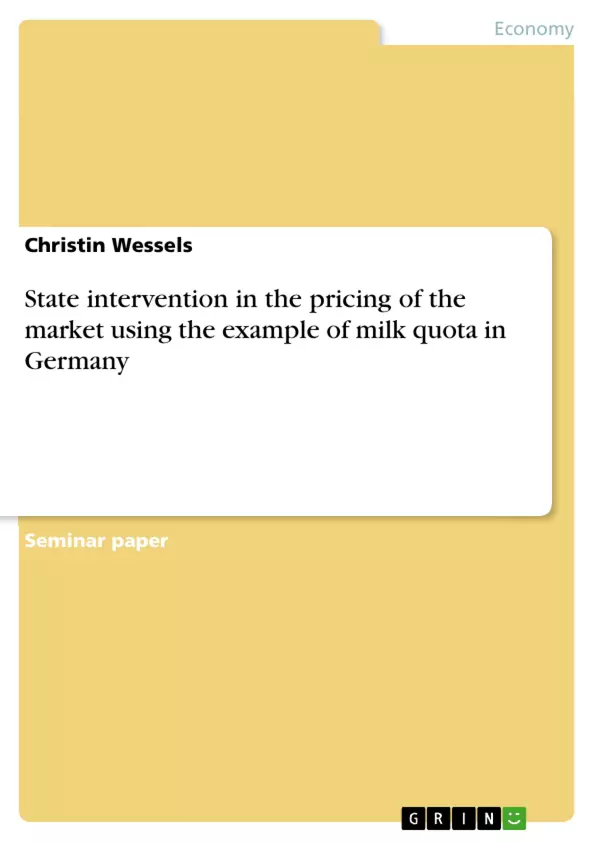Every person as a member of a national economy gets into contact with economizing things, starting with the purchase of food at the supermarket, the weekly visit of the cinema up to accepting and practicing a profession. These activities have one in common: The goods, which are treated, are traded at markets and are determined by supply and demand. At the same time, we influence the prices by our own images. If we accept a job offer, the conditions are important for us, if we buy food, we are only pay as much as we are willing to pay. With our actions we are part of the economy and the economy is part of our life (see Hartmann 2015, p. 13).
The markets adjust themselves but without taking into account vulnerable groups of the population. To compensate the disadvantage of these groups, the government uses different mechanisms (see Mankiw et al. 2012, p.142 ff.). Which mechanisms the government use and what they cause, will be shown in the present assignment using the example of the milk quota.
To achieve this, the methodology of the present assignment is described first, before the theory of supply and demand is explained. The equilibrium of both dimensions is expounded and afterwards the possibilities of the government to influence the equilibrium of demand and supply are explained. In the fourth chapter the milk quota is introduced as a state intervention to regulate the market. In addition it is explained, why there was the need of a milk quota, how it functioned and the advantages and disadvantages of the quota are shown. Finally state interventions in the market at the example of the milk rate will be discussed and an outlook will be given.
Inhaltsverzeichnis (Table of Contents)
- Introduction
- Methodology
- Price formation on markets
- Definition Market
- Pricing of markets
- Demand
- Supply
- Meeting of supply and demand
- Political interference with the price formation
- The milk quota
- Definition
- History
- Functionality and target of the milk quota
- Advantages and disadvantages
- Milk market after elimination of the milk quota
- Conclusion and outlook
Zielsetzung und Themenschwerpunkte (Objectives and Key Themes)
This assignment aims to explore the role of state intervention in the pricing of markets, using the example of the milk quota in Germany. It seeks to understand how state intervention can affect the equilibrium of supply and demand, as well as the advantages and disadvantages of such interventions.
- Price formation in markets
- The role of supply and demand in price determination
- State intervention in market mechanisms
- The milk quota as a case study of state intervention
- The impact of state intervention on market equilibrium
Zusammenfassung der Kapitel (Chapter Summaries)
- Introduction: This chapter introduces the concept of market economics and its impact on daily life. It emphasizes the role of supply and demand in determining prices and the importance of state intervention to address the needs of vulnerable groups.
- Methodology: This chapter outlines the methodology used in the assignment, setting the foundation for the analysis.
- Price Formation on Markets: This chapter explores the fundamental concepts of market pricing, defining markets and discussing the factors that influence demand and supply. It delves into how these factors interact to determine equilibrium prices.
- The Milk Quota: This chapter focuses on the milk quota as a specific example of state intervention in market pricing. It delves into the history, functionality, and objectives of the milk quota, highlighting its advantages and disadvantages.
Schlüsselwörter (Keywords)
This assignment examines the concepts of state intervention, market pricing, supply and demand, equilibrium, milk quota, and its impact on the market. The study explores the advantages and disadvantages of state interventions, emphasizing the importance of understanding how such interventions can impact vulnerable groups.
- Quote paper
- Christin Wessels (Author), 2016, State intervention in the pricing of the market using the example of milk quota in Germany, Munich, GRIN Verlag, https://www.grin.com/document/442179



